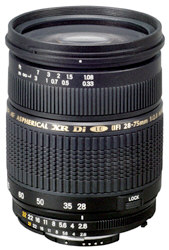
Tamron SP AF28-75/2.8 XR Di LD Aspherical (IF) Macro |
Tamron SP AF28-75/2.8 XR Di LD Aspherical (IF) Macro Lens shown in Nikon mount Of course you can take portraits with anything from a wideangle to a telephoto, but most portraiture is done with short telephotos (80-105mm). A fast (f2.8) lens also lends itself to portraiture, where a smaller DOF gives a more diffuse background. The Tamron SP AF28-75/2.8 XR Di LD Aspherical (IF) Macro is a Tamron "Di" lens. Di lenses designed with digital SLRs in mind and Tamron say that they have higher resolution, better control of flare and ghosting, less light fall-off and lower chromatic aberration than earlier designs. Note that the Tamron SP AF28-75/2.8 XR Di LD Aspherical (IF) Macro has full frame 35mm coverage. Just because it's designated as a "Di" (digitally optimized) lens doesn't mean that it has reduced frame coverage like, for example, the Canon EF-S series lenses. You can use this lens on an APS-C sensor SLR (e.g. Canon EOS 20D) or on a full frame 35mm film body.
The lens solidly constructed with a low reflectivity black finish and a rubberized zoom control. It comes with a "petal" style detachable lenshood. The barrel material appears to be plastic. The zoom can be locked in the 28mm position so that the lens doesn't extend when being carried in a downwards position. Focus can be switched between AF and MF with a small switch on the left, near the lens mount. Manual focus is smooth and well damped with about a 51 degree rotation of the rubberized focus ring from 0.33m to infinity. There are no depth of field scales and no IR focus identification mark. It's marked with focal lengths of 28, 35, 50, 60 and 75mm Focus speed is good. It takes the Tamron SP AF28-75/2.8 XR Di LD Aspherical (IF) Macro about 0.65 seconds to go from 0.33m to infinity (or infinity to 0.33m). Focusing isn't silent but it's pretty quiet and certainly not a problem. The lens extends when zoomed (from around 92mm long at 28mm to around 129mm long at 75mm), but does not change length on focusing (it's internal focus - IF) and the front of the barrel does not rotate when the lens is zoomed or focused. However the focus ring does spin during autofocus, so keep your hands away from it.  Tamron SP AF28-75/2.8 XR Di LD Aspherical (IF) Macro Optical Construction The Tamron SP AF28-75/2.8 XR Di LD Aspherical (IF) Macro uses three types of special optical elements as shown above. XR glass (extra refraction) is glass of high refractive index, used to keep the lens short. LD (low dispersion) glass is used to control and minimize chromatic aberration. Aspherical elements are used to minimize aberrations like spherical aberration which become more troublesome in fast lenses.
The lens has a close focus distance of 0.33m which gives a maximum magnification of 1:3.9 at 75mm. Although the official name of the lens includes the term "macro", it's really more accurately described as "close focusing". True macro lenses usually give 1:2 or 1:1 magnification and are specially optically corrected to ensure low distortion, flat field and high sharpness at very close focus distances. NEXT: Part II - Performance Testing
© Copyright Bob Atkins All Rights Reserved |
|||||||||||||||||||||||||||||||